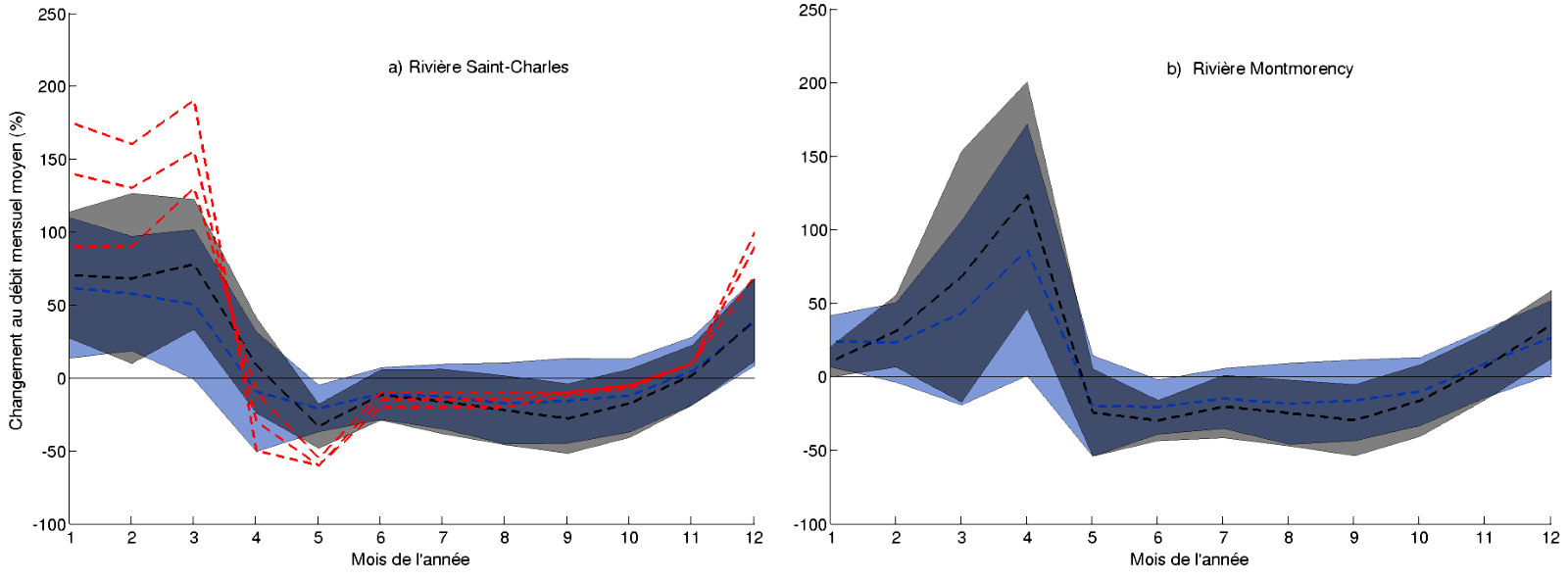Water Balance of the Saint-Charles and Montmorency Rivers in the Context of Climate Change
The main results of this project will be presented to the elected officials and population of the Québec City region to raise awareness about the issue of drinking water availability in a changing climate.
Project details
Principal(s) investigator(s)




Context
The Saint-Charles and Montmorency rivers alone provide drinking water for about 75% of the population of Québec City. However, these two rivers have a low capacity to store water for use in critical periods. Severe low flows in the summers of 2002 and 2010 forced the Communauté métropolitaine de Québec (CMQ) to reopen a pumping station in the nearby Jacques-Cartier river in order to pump more water to the Lac Saint-Charles reservoir.
The rapid population growth of the towns and municipalities in the region over the past few decades, combined with changing climate conditions, could make the management of drinking water more complex during the summer season. Given this context, the CMQ is seeking to learn more about the current and future state of the water resources of the Saint-Charles and Montmorency rivers.
Objective(s)
-
Create an inventory of available observational data on the watersheds under study (weather stations, hydrometric stations, groundwater).
-
Gather scientific studies and/or hydrological models that have been developed and applied to the watersheds of the Saint-Charles and Montmorency rivers, with or without consideration of climate change.
-
Evaluate the current state of knowledge on the future water regime of the Saint-Charles and Montmorency rivers.
Methodology
-
Create a regional scientific committee to study the impact of climate change on the water resources of the Saint-Charles and Montmorency rivers.
-
Identify existing observational data and previous studies on the Saint-Charles and Montmorency river watersheds.
-
Estimate the future water regime of the Saint-Charles and Montmorency rivers (2050 and 2080 horizons), based on the studies identified in the previous point.
-
Work with the scientific committee to identify future research needs and to fill current gaps in the state of knowledge.
Results
Due to the presence of Québec City, the south of the study area has a high density of provincial and federal weather stations, while there are less data available for the central and northern areas of the watersheds. However, only the Aéroport Jean-Lesage and Forêt Montmorency stations have 30 years or more of historical data. These two stations also stand out for their use of equipment to monitor precipitation at a high temporal resolution.
Two hydrometric stations are located near Québec City water intakes on the Saint-Charles and Montmorency rivers, and have long series of historical data. Since 2008 and 2009, two new hydrometric stations have been set up on tributaries of Lac Saint-Charles in order to study the water supply to the lake. As regards groundwater, the Programme d’acquisition de connaissances sur les eaux souterraines (PACES) is the most up-to-date resource for aquifer mapping (2013).
Eight hydro(geo)logical studies conducted between 2008 and 2015 were identified. Of these, two studies analyze the impact of climate change on water resources for the 2050 and 2080 time horizons in comparison to the reference period 1971-2000. The most comprehensive study covers six rivers in the region and is based on 187 climate scenarios for the 2050 time horizon (89 CMIP3/MRC-C/NARCCAP simulations and 98 CMIP5 simulations). This study, illustrated in Figure 1, compares simulated flows for the 2050 time horizon to those observed over the reference period (1970-2000).

Figure 1. Projected change in average monthly flow of the Saint-Charles and Montmorency rivers for the 2050 time horizon in comparison to 1971-2000, under CMIP3 (blue) and CMIP5 (grey) climate scenarios. The dashed line indicates the average value. Within a particular simulation, the spread in the results includes half of the climate scenarios analyzed. The red lines indicate the results for the 2080 time horizon.
It suggests a decrease in average summer flow of up to -45%. On the other hand, average winter flow (in January and February, months that are currently problematic due to low flow) could increase significantly (by as much as +130%). Low flow rates vary in a similar manner to average flow rates. We can therefore expect more severe summer low flows (up to 50%), while river flow during winter low flow periods could be more sustained (up to +80%). The volume of the spring flood flow is important, as it helps to fill reservoirs such as Lac Saint-Charles at the end of winter.
The direction of change for this indicator is uncertain, as a difference of -25% to +15% is expected in comparison to the reference period. One reason for this is the high sensitivity of this parameter to future winter conditions. Many avenues for research remain to be explored. The study conducted for the 2080 horizon, for example, constitutes a high-quality hydrogeological study that is worth duplicating for shorter time horizons, using more numerous and more recent climate scenarios. It is reasonable to assume that the availability of groundwater should vary in a similar manner to surface water, but this aspect remains relatively unknown, even though it affects the drinking water supply of several tens of thousands of people in the territory of the CMQ.
The impact of climate change for the 2030 time horizon is another research area of interest that could prove very useful for decision-makers, and could be the subject of future studies.
Benefits for adaptation
Benefits for adaptation
The main results of this project will be presented to the elected officials and population of the Québec City region to raise awareness about the issue of drinking water availability in a changing climate.
These results constitute a first step toward future research projects in collaboration with the scientific committee created at the beginning of the project.
Scientific publications
Funding

Other participants
-
Institut National de Recherche Scientifique (INRS)
-
Université Laval